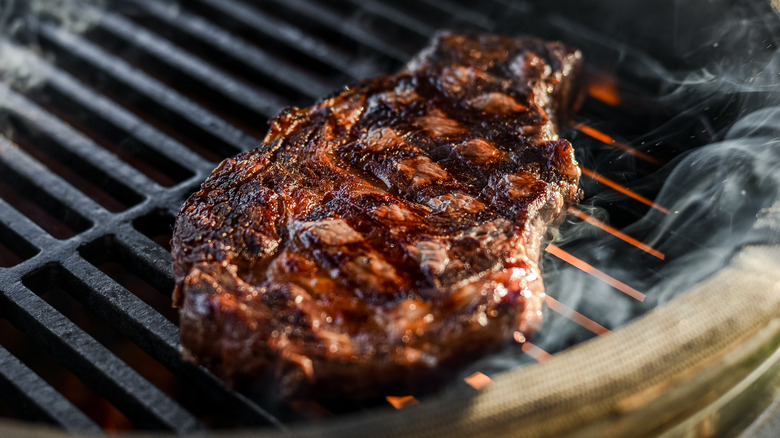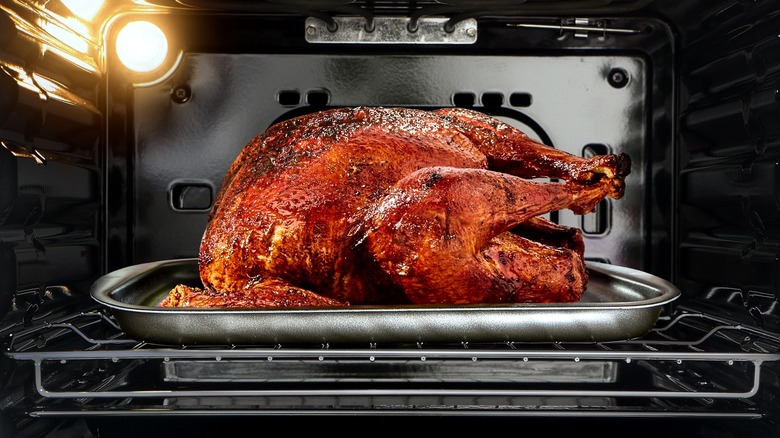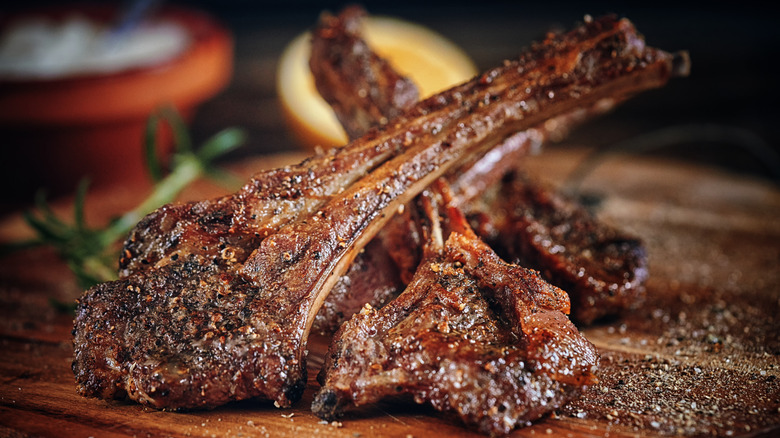The Best Meats To Air-Dry For A Satisfying Crust
Countless articles have been written about the best internal temperature for cooking various meats, but people often seem to neglect the exterior of meat. This is a tragic oversight, as the outer surface can provide a huge boost to both the flavor and texture of meat. Steaks and lamb chops should have a nice, dark crust; a whole roasted chicken or turkey needs a crispy, golden skin. The key to achieving these is quite simple. All you need to do is air-dry the meat.
Air-drying involves letting the meat rest, uncovered, until all of the moisture on its surface evaporates, leaving the exterior totally dry. You might wonder what the point of all this is, and it has to do with the Maillard reaction. The Maillard reaction is one of the most important chemical reactions to know about when it comes to cooking. It's the reason meat changes color as it cooks, and it is also the key to achieving a satisfying crust, but only if the meat is dry.
The Maillard reaction only happens when meat hits 300 degrees Fahrenheit, and since water boils at 212 degrees Fahrenheit, meat with moisture on the surface is incapable of getting that nice crust. That's why air-drying is so essential. It primes the surface of the meat to trigger the Maillard reaction. The best part? Air-drying works with practically any type of meat you can think of, including steaks, pork chops, and lamb chops.
Air-drying can enhance practically any meat
Air-drying is most often discussed in the context of beef. It's most helpful for steaks, for which a good crust is absolutely mandatory. Other meats that work well for air-drying are pork chops and lamb chops. What all of these meats have in common is the fact that you cook them at high heat, typically on a grill or in a cast iron pan. When dry meat hits high heat, a perfect crust will form.
As far as poultry is concerned, air-drying works best on skin-on chicken and turkey. You can keep the interior moist using techniques to prevent dry chicken, such as brining, and then air-dry the meat as the final step before cooking. Air-drying might not work as well for skinless cuts of poultry though, as those are very prone to drying out when you cook them.
The choice to air-dry meat doesn't just depend on the type of meat, but also the way you are cooking it. Air-drying is especially important for smoked meat, including smoked fish, because the dryer the surface of the meat is, the better the smoke will cling to it and provide the flavor you're looking for.
How to air dry meat
No matter what kind of meat you're working with, the basic air-drying process will be the same. To properly air-dry meat, you need its entire surface to be exposed to the air. You can't just plop the meat on a plate and leave it in the fridge, because the part that's touching the plate will never dry out. Instead, get a wire rack, such as a cooling rack for baked goods, and set it on a baking sheet. Place your meat on top of that and place it in the fridge.
Refrigerators provide a very dry environment, and as that cool, dry air circulates the meat, moisture on the surface will steadily evaporate. However, you need to be conscious of cross-contamination. To prevent your uncovered meat from contaminating other items in your fridge while it air-dries, place it on the bottom shelf.
As far as the right amount of time to air dry meats is concerned, it really depends on the size of the piece of meat you're using. Small cuts, like steaks and lamb chops, only need a few hours of air-drying while big cuts, like roasts, need a full day or two because of their larger surface area. You will know the meat is ready when the surface is completely dry to the touch. If you're short for time and the air-drying process doesn't have time to complete, you can pat any lingering moisture off with a paper towel.


